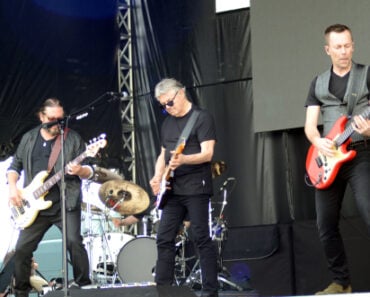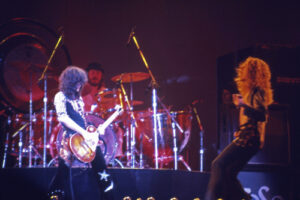
Feature Photo: DarioZg / Shutterstock.com
The Cult began their journey in 1981 when Ian Astbury formed Southern Death Cult in Bradford. After the dissolution of Southern Death Cult in March 1983, Astbury teamed with guitarist Billy Duffy to form Death Cult in April 1983, enlisting bassist Jamie Stewart and drummer Ray “Mondo” Taylor-Smith from the London-based band Ritual to complete their initial lineup. The band made their live debut in Oslo, Norway in July 1983 and released their self-titled Death Cult EP the same month. Following the dismissal of Mondo in September 1983 and his replacement with Nigel Preston from Sex Gang Children, the group issued one final release under the Death Cult name with “Gods Zoo” before shortening their moniker to simply The Cult in January 1984. This transformation marked the beginning of one of Britain’s most enduring and influential rock bands, which has navigated multiple stylistic evolutions, lineup changes, and industry upheavals across more than four decades.
The Cult’s discography spans eleven studio albums, beginning with their 1984 debut “Dreamtime,” which peaked at number 21 on the UK Albums Chart and achieved silver certification. Their commercial breakthrough came with 1985’s “Love,” which reached number 4 in the UK and remained on the charts for 22 weeks, featuring the hit singles “She Sells Sanctuary,” “Rain,” and “Revolution.” The band’s evolution from post-punk origins to hard rock powerhouse was cemented with 1987’s Rick Rubin-produced “Electric,” which also peaked at number 4 in the UK and spawned hits including “Love Removal Machine” and “Lil’ Devil.” Their commercial peak arrived with 1989’s “Sonic Temple,” produced by Bob Rock, which reached the top 10 in both the UK and US, achieved platinum certification, and featured their biggest hit “Fire Woman.” Despite creative tensions leading to multiple breakups in 1995 and 2002, The Cult has continued releasing albums including “Beyond Good and Evil” (2001), “Born into This” (2007), “Choice of Weapon” (2012), “Hidden City” (2016), and their most recent effort “Under the Midnight Sun” (2022).
Throughout their career, The Cult has experienced significant lineup instability, with Astbury and Duffy remaining as the only consistent members while various bassists, drummers, and keyboardists have contributed to their sound. The band’s creative tensions, particularly between the core songwriting partnership of Astbury and Duffy, have been well-documented and have resulted in multiple hiatuses and reformations. During their inactive periods, both principal members have pursued other projects: Astbury fronted Holy Barbarians in the mid-1990s, released a solo album “Spirit/Light/Speed” in 2000, and notably served as vocalist for the Doors of the 21st Century (later Riders on the Storm) from 2002 to 2007, while Duffy has been involved with various bands including Coloursound, Dead Men Walking, and Cardboard Vampyres. Despite these challenges, The Cult’s influence on alternative rock, gothic rock, and hard rock genres remains substantial, with their music continuing to attract new generations of fans and their live performances maintaining their reputation as one of rock’s most compelling acts.
Ian Astbury
Ian Astbury has served as The Cult’s lead vocalist, frontman, and primary lyricist since the band’s formation, bringing a distinctive shamanic presence and powerful vocal delivery that has become synonymous with the band’s identity. Born on May 14, 1962, in Heswall, Cheshire, Astbury moved to Canada with his family in 1973 before returning to England in 1980, where he became active in Liverpool’s punk scene centered around Eric’s Club. His musical journey began in Bradford in 1981 when he formed Southern Death Cult, a post-punk band that gained a devoted following before dissolving in March 1983. Astbury’s fascination with Native American culture, spirituality, and mythology has profoundly influenced The Cult’s thematic content, particularly evident in early albums like “Dreamtime” and “Love,” where songs such as “Spiritwalker” and “Horse Nation” incorporated shamanic and indigenous themes.
As The Cult’s principal songwriter alongside Billy Duffy, Astbury has demonstrated remarkable adaptability across the band’s stylistic evolution from post-punk to hard rock to alternative rock. His vocal style ranges from the ethereal delivery of early Gothic rock material to the commanding presence required for arena rock anthems like “Fire Woman” and “Love Removal Machine.” Astbury has performed on all eleven of The Cult’s studio albums, from “Dreamtime” (1984) through “Under the Midnight Sun” (2022), consistently serving as the band’s creative visionary and public face. His lyrics often explore themes of spirituality, love, loss, and mysticism, delivered with a theatrical intensity that has made him one of rock’s most distinctive frontmen.
Beyond The Cult, Astbury has pursued various solo and collaborative projects that have expanded his artistic range. During The Cult’s mid-1990s hiatus, he formed Holy Barbarians, releasing the album “Cream” in 1996, which showcased a more introspective and alternative rock approach. His 2000 solo album “Spirit/Light/Speed” further explored personal and spiritual themes while maintaining connections to his rock roots. Perhaps most notably, Astbury served as the lead vocalist for the Doors of the 21st Century (later renamed Riders on the Storm) from 2002 to 2007, performing alongside original Doors members Ray Manzarek and Robby Krieger. This collaboration allowed him to interpret the classic Doors catalog while honoring Jim Morrison’s legacy, though the project faced legal challenges from Morrison’s estate and drummer John Densmore. Astbury has also contributed vocals to various artists’ recordings and has been involved in numerous benefit concerts and social causes throughout his career.
Billy Duffy
Billy Duffy has anchored The Cult as their lead guitarist since the band’s formation in 1983, providing the distinctive guitar sound that has defined their music across multiple decades and stylistic transformations. Born in Manchester, Duffy’s musical journey began in the late 1970s punk scene, where he played with several bands including the Nosebleeds (alongside future Smiths frontman Morrissey), Lonesome No More, and Theatre of Hate. His collaboration with Ian Astbury began when Theatre of Hate toured with Southern Death Cult, leading to a friendship that would become one of rock’s most enduring creative partnerships. Duffy’s guitar style combines punk aggression with classic rock sensibilities, incorporating elements ranging from post-punk atmospherics to heavy metal power, often utilizing effects pedals and distinctive tone to create The Cult’s signature sound.
Duffy’s guitar work has been integral to The Cult’s evolution through their various phases, from the jangly, atmospheric textures of “Love” to the full-throttle rock assault of “Electric” and “Sonic Temple.” His most famous composition, “She Sells Sanctuary,” co-written with Astbury, features a distinctive linear riff that became one of the defining songs of 1980s alternative rock. Throughout The Cult’s discography, Duffy has demonstrated versatility in adapting his playing to serve the songs while maintaining his distinctive voice as a guitarist. His collaboration with renowned producers including Rick Rubin and Bob Rock has resulted in some of the most powerful guitar sounds in rock music, particularly on albums like “Electric” and “Sonic Temple,” where his guitar work achieved both commercial success and critical acclaim.
During The Cult’s various hiatuses, Duffy has remained active through numerous side projects and collaborations that have showcased different aspects of his musical personality. He formed Coloursound with bassist Craig Adams and ex-Alarm frontman Mike Peters, exploring a different musical direction from The Cult’s hard rock sound. He also participated in Dead Men Walking (again with Peters) and later Cardboard Vampyres, demonstrating his willingness to experiment with different musical styles and partnerships. Duffy has described his role in The Cult as the “bandleader” and “engine room,” taking responsibility for the musical arrangements and incorporation of session musicians while Astbury focuses on the visual and conceptual elements. His pragmatic approach to the music business and his ability to maintain professional relationships has been crucial to The Cult’s longevity, even during periods of creative tension with Astbury.
Jamie Stewart
Jamie Stewart served as The Cult’s original bassist from the band’s formation in 1983 until 1990, providing the rhythmic foundation during their most successful commercial period and creative evolution. Stewart joined the band as part of the rhythm section from the London-based post-punk band Ritual, bringing professional experience and musical sophistication that helped establish The Cult’s sound. His bass playing can be heard on The Cult’s first four studio albums: “Dreamtime” (1984), “Love” (1985), “Electric” (1987), and “Sonic Temple” (1989), representing the band’s progression from post-punk Gothic rock to arena-ready hard rock. Stewart’s melodic bass lines and solid rhythmic foundation were particularly crucial during the band’s transformation under producer Rick Rubin on “Electric,” where his playing helped bridge their earlier atmospheric sound with their harder rock direction.
Stewart’s most significant contributions to The Cult came during their commercial breakthrough period, particularly on “Love” and “Sonic Temple.” His bass work on songs like “She Sells Sanctuary,” “Fire Woman,” and “Edie (Ciao Baby)” provided the driving pulse that made these tracks radio staples and concert favorites. During the “Electric” sessions and tour, Stewart adapted his playing style to accommodate the heavier, more guitar-driven approach that Rick Rubin brought to the band’s sound. His professional approach and musical reliability made him an anchor for the band during their most turbulent creative periods, when lineup changes and stylistic shifts could have derailed their momentum.
After leaving The Cult in April 1990 to focus on producing, composing, and spending time with his family, Stewart continued his involvement in music from behind the scenes. His departure marked the end of an era for The Cult, as he had been present during their evolution from underground post-punk act to mainstream rock success. Stewart’s exit was followed shortly by drummer Matt Sorum’s departure to join Guns N’ Roses, leading to significant changes in The Cult’s lineup and musical direction. Despite leaving the band, Stewart has occasionally reunited with The Cult for special performances, including a notable appearance during their “Love Live Tour” in 2009 at the Royal Albert Hall, where he performed alongside original “Love” album drummer Mark Brzezicki, demonstrating the enduring bonds formed during the band’s classic period.
Matt Sorum
Matt Sorum joined The Cult as their touring drummer in 1989 for the “Sonic Temple” tour, marking a crucial period in both his career and the band’s evolution toward mainstream rock success. Although Mickey Curry performed drums on the “Sonic Temple” album recording, Sorum was recruited for the extensive touring cycle that followed, bringing his powerful, hard-hitting style to The Cult’s increasingly heavy live sound. His association with The Cult proved to be a launching pad for his career, as his performances with the band caught the attention of Guns N’ Roses guitarist Slash, who was seeking a replacement for Steven Adler. Sorum’s audition process with The Cult and subsequent touring experience helped establish him as one of rock’s most sought-after drummers.
During his initial tenure with The Cult in 1989-1990, Sorum helped the band navigate their transition from the post-punk underground to arena rock stardom. His drumming style, which combined technical precision with the power necessary for large venues, proved ideal for The Cult’s hard rock direction. The “Sonic Temple” tour was highly successful, establishing the band as a major touring draw and introducing their music to larger audiences worldwide. Sorum’s performance during this period demonstrated his ability to adapt to different musical styles while maintaining his distinctive approach to rock drumming.
After leaving The Cult in July 1990 to join Guns N’ Roses, Sorum’s career trajectory took him through some of rock’s most high-profile projects, including seven years with Guns N’ Roses and later co-founding Velvet Revolver with former GNR members Slash and Duff McKagan. However, his connection to The Cult remained strong, and he returned to the band in 1999 when Ian Astbury and Billy Duffy reformed the group after their four-year hiatus. Sorum’s second stint with The Cult included recording their comeback album “Beyond Good and Evil” (2001) and participating in extensive touring through 2001. His return brought stability and star power to The Cult’s reunion, helping to re-establish their credibility and commercial viability after years of separation. Sorum’s dual relationship with The Cult as both a launching point and a return destination illustrates the band’s role as a crucial stepping stone and creative home for many musicians throughout their career.
John Tempesta
John Tempesta has served as The Cult’s drummer since 2006, providing the rhythmic backbone for the band’s modern era and longest period of lineup stability in their history. Born and raised in the Bronx, Tempesta built an impressive resume in heavy metal and hard rock before joining The Cult, including notable tenures with Exodus, Testament, White Zombie, Rob Zombie’s solo project, Helmet, and Black Label Society. His extensive experience across different subgenres of metal and rock made him an ideal fit for The Cult’s diverse catalog, which spans from atmospheric post-punk to heavy arena rock. Tempesta’s recruitment to The Cult came through industry connections when the band was auditioning drummers in early 2006, and his familiarity with their music and professional approach quickly secured him the position.
Tempesta’s drumming style brings both power and dynamics to The Cult’s music, allowing the band to perform their classic material with renewed energy while adapting to new compositions. His technical proficiency and experience with heavy music has enabled The Cult to maintain their edge in live performances while exploring different musical territories in their studio recordings. Since joining the band, Tempesta has recorded on four studio albums: “Born into This” (2007), “Choice of Weapon” (2012), “Hidden City” (2016), and “Under the Midnight Sun” (2022). His drumming on these albums demonstrates his ability to serve the songs while bringing his own musical personality to the arrangements, particularly evident in his work with producer Chris Goss, known as “The Godfather of Desert Rock.”
Beyond his work with The Cult, Tempesta has maintained an active career in the music industry, including guest recording sessions and collaborations with diverse artists. His versatility as a drummer has led to opportunities ranging from acoustic projects with Rodrigo y Gabriela and a Cuban orchestra to heavy metal sessions with various artists. Tempesta’s professional approach and extensive touring experience have made him a valuable asset to The Cult’s operations, contributing to their ability to maintain an active touring schedule and continue recording new material. His nearly two-decade tenure with the band represents the longest drummer relationship in The Cult’s history, providing the stability that has allowed Astbury and Duffy to focus on their creative partnership without the disruptions that characterized earlier periods of the band’s career.
Nigel Preston
Nigel Preston served as The Cult’s drummer during a crucial transitional period from 1983 to 1985, contributing to their evolution from the gothic post-punk sound of Death Cult to the more accessible rock approach of their breakthrough album “Love.” Preston joined the band in September 1983, replacing Ray “Mondo” Taylor-Smith who had been deported to Sierra Leone, and brought experience from his previous tenure with the influential gothic rock band Sex Gang Children. His recruitment was part of a mutual exchange, as Mondo took Preston’s place in Sex Gang Children, demonstrating the interconnected nature of the early 1980s alternative rock scene. Preston’s drumming style, influenced by post-punk and gothic rock aesthetics, helped establish The Cult’s early sound and contributed to their growing reputation in the UK underground music scene.
Preston’s most significant contribution to The Cult’s catalog came during the recording sessions for what would become their debut album “Dreamtime” in 1984. His drumming provided the rhythmic foundation for songs like “Spiritwalker,” which reached number 1 on the UK Independent Singles Chart, and other tracks that established The Cult’s distinctive blend of mysticism and rock power. Preston’s playing during this period reflected the band’s post-punk origins while anticipating their evolution toward more accessible rock music. His work on “Dreamtime” helped establish The Cult as a significant force in the UK alternative scene and laid the groundwork for their subsequent commercial success.
However, Preston’s tenure with The Cult was marked by increasing unreliability that ultimately led to his dismissal in May 1985, shortly after the release of “She Sells Sanctuary.” His absence from the music video shoot for their breakthrough single necessitated the use of Mark Brzezicki from Big Country as a substitute drummer, foreshadowing the end of his time with the band. Preston’s departure came at a critical moment when The Cult was gaining mainstream attention, and his unreliability threatened to undermine their momentum. Following his exit, Brzezicki continued as a session drummer for the remainder of the “Love” album sessions, which became The Cult’s commercial breakthrough. Despite his relatively brief tenure and problematic conclusion, Preston’s contributions during The Cult’s formative period were essential to their development from underground gothic act to mainstream rock success.
Mark Brzezicki
Mark Brzezicki served as The Cult’s session drummer during the recording of their breakthrough album “Love” in 1985, stepping in during a crucial period when the band needed reliability and professionalism to complete their most important recording to date. As the drummer for the successful Scottish rock band Big Country, Brzezicki brought significant experience and technical skill to The Cult’s sessions at Jacob’s Studios in Farnham, Surrey. His involvement with the band began when Nigel Preston failed to appear for the filming of “She Sells Sanctuary,” necessitating a last-minute replacement. Brzezicki’s professional approach and musical compatibility with the band’s evolving sound made him the obvious choice to complete the album after Preston was dismissed for unreliability.
Brzezicki’s drumming on “Love” provided the solid rhythmic foundation that helped transform The Cult from a cult Gothic rock band into mainstream contenders. His work on tracks like “She Sells Sanctuary,” “Rain,” and “Revolution” demonstrated his ability to adapt his playing style to serve The Cult’s unique blend of post-punk atmosphere and emerging hard rock sensibilities. His session work was characterized by both technical precision and musical sensitivity, allowing the songs to breathe while providing the power necessary for radio appeal. The success of “Love,” which reached number 4 on the UK Albums Chart and remained there for 22 weeks, can be partially attributed to Brzezicki’s professional drumming, which gave the album a cohesive sound despite the challenging circumstances of its creation.
Although Brzezicki’s time as The Cult’s regular drummer was brief, his impact on their career trajectory was significant. The “Love” album became The Cult’s commercial breakthrough, establishing them as a major force in alternative rock and setting the stage for their subsequent evolution into hard rock with “Electric” and “Sonic Temple.” Brzezicki’s professional approach during a period of instability helped ensure that The Cult’s most important early album was completed successfully. His connection to the band has endured over the decades, as evidenced by his special guest appearance during The Cult’s “Love Live Tour” in 2009, when he joined original bassist Jamie Stewart for a performance at the Royal Albert Hall, recreating the classic “Love” album lineup for longtime fans and demonstrating the lasting bonds formed during those crucial recording sessions.
Mickey Curry
Mickey Curry served as the session drummer for The Cult’s most successful album, “Sonic Temple” (1989), bringing his expertise as a member of Bryan Adams’s band to help create the polished, radio-friendly sound that would define the album’s massive commercial success. Curry was recruited specifically for the recording sessions after The Cult had experimented with various drummers during demo recording sessions, including future Kiss drummer Eric Singer and Chris Taylor from producer Bob Rock’s group Rock and Hyde. His selection for the final album recording reflected the band’s desire to achieve the highest level of professionalism and sonic quality for what they knew would be a crucial release in their career. Curry’s drumming style, which combined power with precision and commercial sensibility, proved ideal for the arena rock direction The Cult was pursuing under Bob Rock’s production.
Curry’s contributions to “Sonic Temple” were instrumental in creating the album’s distinctive sound, which successfully balanced The Cult’s mystical and spiritual themes with accessible hard rock arrangements. His drumming on tracks like “Fire Woman,” “Edie (Ciao Baby),” and “Sweet Soul Sister” provided the powerful foundation that helped these songs become radio staples and MTV favorites. The album’s success, reaching the top 10 in both the UK and US while achieving platinum certification, can be partially attributed to Curry’s professional approach and understanding of what was required for mainstream rock radio. His session work demonstrated the importance of having experienced musicians who understood both the technical and commercial aspects of recording major-label albums.
Although Curry’s involvement with The Cult was limited to the “Sonic Temple” recording sessions, his impact on the band’s career was substantial. The album represented The Cult’s commercial peak and established them as a major force in the hard rock scene of the late 1980s. Curry’s drumming helped bridge the gap between The Cult’s post-punk origins and their arena rock aspirations, creating a sound that satisfied both longtime fans and new mainstream audiences. His work on the album also established a template for The Cult’s subsequent recordings, demonstrating the effectiveness of working with seasoned session musicians when pursuing commercial success. The enduring popularity of “Sonic Temple” and its songs in The Cult’s live performances continues to showcase Curry’s contributions to the band’s legacy, even though his direct involvement was brief.
Chris Wyse
Chris Wyse has served multiple tenures as The Cult’s bassist, demonstrating remarkable consistency and adaptability across different phases of the band’s evolution from 2000 to 2020. His initial involvement with The Cult began during the recording of their comeback album “Beyond Good and Evil” (2001), where he contributed bass parts alongside Martyn LeNoble, who had been the primary bassist during the early reunion period. Wyse’s professional approach and musical compatibility with Ian Astbury and Billy Duffy’s songwriting made him a natural fit for the band’s reformed lineup. His bass playing combined the melodic sensibility necessary for The Cult’s earlier material with the power required for their harder rock direction, making him valuable for both studio recordings and live performances.
Wyse’s most significant period with The Cult came when he rejoined the band in 2006 as part of their second reunion, alongside drummer John Tempesta. This lineup proved to be one of The Cult’s most stable and productive, remaining together for several years and releasing multiple albums including “Born into This” (2007) and “Choice of Weapon” (2012). Wyse’s bass work during this period helped establish a renewed creative momentum for the band, providing a solid foundation that allowed Astbury and Duffy to explore new musical territories while maintaining their distinctive sound. His playing style evolved to accommodate The Cult’s modern approach while preserving the essential elements that made their classic material effective.
Throughout his tenure with The Cult, Wyse maintained active involvement in other musical projects, demonstrating the kind of professional versatility that has become increasingly common in the modern music industry. His ability to balance his commitment to The Cult with other musical opportunities reflected his understanding of the band’s working methods and the collaborative nature of their creative process. Wyse’s departure from the band in 2020 marked the end of a significant era for The Cult, as his fourteen-year association (with interruptions) represented one of the longest bassist relationships in the band’s history. His replacement by Charlie Jones for the “Under the Midnight Sun” album continued The Cult’s tradition of working with experienced, professional musicians who could contribute to their ongoing evolution while respecting their musical legacy.
Check out more The Cult articles on ClassicRockHistory.com Just click on any of the links below……
Complete List Of The Cult Albums And Discography
Top 10 Songs From The Cult
Read More: Artists’ Interviews Directory At ClassicRockHistory.com
Read More: Classic Rock Bands List And Directory



































